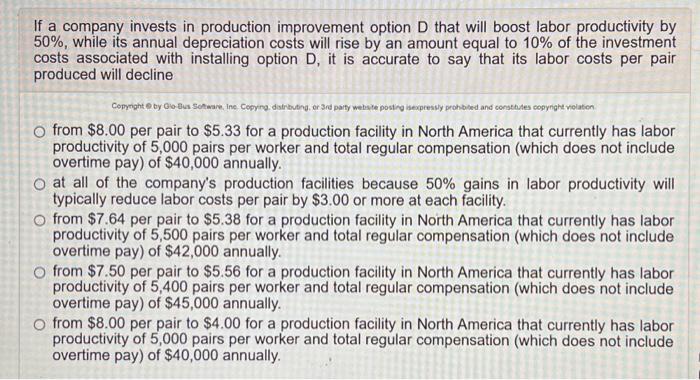If a company invests in production improvement option D that will boost labor productivity by 50%, while its annual depreciation costs will rise by an amount equal to 10% of the investment costs associated with installing option D, it is accurate to say that its labor costs per pair produced will decline from $8.00 per pair to $5.33 for a production facility in North America that currently has labor productivity of 5,000 pairs per worker and total regular compensation (which does not include overtime pay) of $40,000 annually. at all of the company's production facilities because 50% gains in labor productivity will typically reduce labor costs per pair by $3.00 or more at each facility. from $7.64 per pair to $5.38 for a production facility in North America that currently has labor productivity of 5,500 pairs per worker and total regular compensation (which does not include overtime pay) of $42,000 annually. from $7.50 per pair to $5.56 for a production facility in North America that currently has labor productivity of 5,400 pairs per worker and total regular compensation (which does not include overtime pay) of $45,000 annually. from $8.00 per pair to $4.00 for a production facility in North America that currently has labor productivity of 5,000 pairs per worker and total regular compensation (which does not include overtime pay) of $40,000 annually. If a company invests in production improvement option D that will boost labor productivity by 50%, while its annual depreciation costs will rise by an amount equal to 10% of the investment costs associated with installing option D, it is accurate to say that its labor costs per pair produced will decline from $8.00 per pair to $5.33 for a production facility in North America that currently has labor productivity of 5,000 pairs per worker and total regular compensation (which does not include overtime pay) of $40,000 annually. at all of the company's production facilities because 50% gains in labor productivity will typically reduce labor costs per pair by $3.00 or more at each facility. from $7.64 per pair to $5.38 for a production facility in North America that currently has labor productivity of 5,500 pairs per worker and total regular compensation (which does not include overtime pay) of $42,000 annually. from $7.50 per pair to $5.56 for a production facility in North America that currently has labor productivity of 5,400 pairs per worker and total regular compensation (which does not include overtime pay) of $45,000 annually. from $8.00 per pair to $4.00 for a production facility in North America that currently has labor productivity of 5,000 pairs per worker and total regular compensation (which does not include overtime pay) of $40,000 annually







